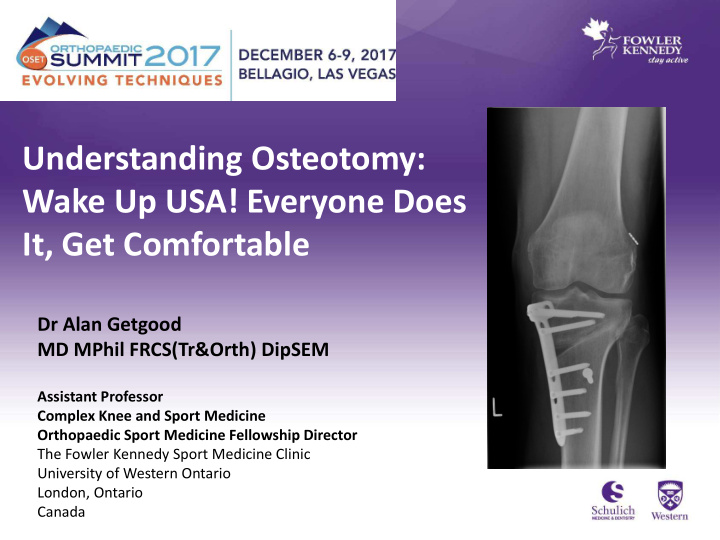



Understanding Osteotomy: Wake Up USA! Everyone Does It, Get Comfortable Dr Alan Getgood MD MPhil FRCS(Tr&Orth) DipSEM Assistant Professor Complex Knee and Sport Medicine Orthopaedic Sport Medicine Fellowship Director The Fowler Kennedy Sport Medicine Clinic University of Western Ontario London, Ontario Canada
Disclosures • Research Support • Editorial Board – Canadian Foundation for – AJSM Social Media Innovation – ISAKOS/OREF – Musculoskeletal Transplant Foundation • Consultant – Canadian Institute for Health – Smith & Nephew Inc. Research – Arthritis Society – Conmed Inc. – Ontario Research Fund – Depuy Synthes Inc. – Smith & Nephew Inc. – Arthrex Inc. – Ferring Inc. – Conmed Inc. – Ossur Inc. – Depuy Synthes Inc. – Eupraxia Inc. – SBM Inc.
Bare Bone Facts Younger Patient Demand for Primary and Revision Joint Replacement: National Projections from 2010 to 2030 The Journal of Arthroplasty , Volume 24, Issue 2, Pages e34-e34 S. Kurtz , E. Lau, K. Ong, K. Zhao, M. Kelly, K. Bozic • By 2030, the demand for TJA by patients <65y is projected to be 52% of primary THAs and 55-62% of primary or revision TKAs • The future demand was projected to grow the fastest for the 45-54y age category for primary TKA, which was anticipated to grow from 59,077 in 2006 to 994,104 (17 times) by 2030 .
Knee Preservation Timeline… <55 yrs old 55 yrs old >75 yrs old Osteotomy/ Osteotomy UKA TKA Joint Preservation Young, active Active, Retired, Demanding Jobs manual work Sedentary Sport
Treatment Strategy: Aim to stay in the green zone: Romain Seil 2015
HTO vs. UKA
HTO vs. UKA • Would you rather revise an HTO or a UKA?
Why not UKA? Swedish Registry LHSC Data Kaplan-Meier Survival (All Revisions for Surgeries 10 years or Greater from the time of surgery) 92.9% TKA Cumulative Survival 80.6% UKA Survival Time (Years)
Australian Registry: % Revised Log-rank test for equality over strata p-value < 0.001 Hazard Ratio (adjusted for age and sex; Unicompartmental for OA V Total Knee for OA = 2.02; 95% CI (1.90,2.14) p-value < 0.001 21.0% UKA Cumulative Percent revised n= 45,615 • % UKA in Australia 7.3% TKA – 15.1% in 2003 – 9.7% in 2007 n= 494,571 – 5.7% in 2012 15 yrs years since primary procedure – 4.8% in 2015
Australian Registry: Age 32.5% (15.7) • < 55 yo – 32.5% rev rate at 15 yrs 24.6% (9.9) • > 75 yo – 9.3% 16.8% (6.5) rev rate at 13 yrs, ? (3.2)
Higher Revision rate for UKA is offset by greater patient satisfaction? NO! Distribution of Satisfaction (%) Swedish Registry Very Satisfied TKA (12,298) & UKA (7,860) Satisfied IDENTICAL Uncertain Robertsson et al, Dissatisfied Acta Orthop Scand, 2000 (12,298) (7,860)
What are we trying to achieve? 1. Coronal plane correction – To reduce the external knee adduction moment (varus knee) or abduction moment (valgus knee) 2. Sagittal plane correction – Alter tibial slope to reduce tibial translation and achieve sagittal balance
Re-alignment Osteotomy
Does it work? Reduction in knee adduction moment (KAM) in the varus knee correlates with KOOS MCID
What happens to Articular Cartilage after HTO? Improvement in quality and volume of repair tissue
Evidence - HTO 70% 10 yr survivorship
Evidence – Varus osteotomy
HTO + cartilage repair
Coronal Alignment - Effect on Collaterals and Cruciates
What are we trying to achieve? 1. Coronal plane correction – To reduce the external knee adduction moment (varus knee) or abduction moment (valgus knee) 2. Sagittal plane correction – Alter tibial slope to reduce tibial translation and achieve sagittal balance
Biplanar Osteotomy (correction) • Sagittal plane correction Reduce shear strain on ACL or • PCL by reducing or increasing the posterior tibial slope respectively Alters tibiofemoral contact • pressure • 1mm of correction = 1 o of slope change
Indications for Realignment Osteotomy • Coronal alignment – Unicompartmental OA – Joint restoration – Ligament instability • Sagittal alignment – Tibial slope – Posterior/anterior wear – ACL/PCL
Joint Restoration Philosophy • Realignment Osteotomy • Ligament Reconstruction Biomechanics • Meniscus Allograft Transplantation • Articular Cartilage Repair Biology • Adjuvant Therapies
Surgical Pearls for Osteotomy Fluoroscopy from ipsilateral • side Stand on contralateral side • MOWHTO • – Distal MCL release – Posterior Retractor – Biplane Osteotomy • Increased surface area • Greater rotational control Slope • – Maintain: Y1 = Y2 x2 – Increase: Y1 = Y2 – Decrease: Y1 < Y2 – You have to destabilize the lateral hinge
Surgical Pearls for Osteotomy Fluoroscopy from ipsilateral • side Stand on contralateral side • MOWHTO • – Distal MCL release – Posterior Retractor – Biplane Osteotomy • Increased surface area • Greater rotational control Slope • – Maintain: Y1 = Y2 x2 – Increase: Y1 = Y2 – Decrease: Y1 < Y2 – You have to destabilize the lateral hinge
Surgical Technique
Summary • Osteoarthritis on the rise – will effect more younger individuals • We are aware of the treatment gap for OA…. • Osteotomy a key component to address that gap • Aim to keep young patients in the green/preservation zone • Indications remain consistent – education is the key….
Thank you! ‘Fake Knees are NOT the answer…..’
Recommend
More recommend